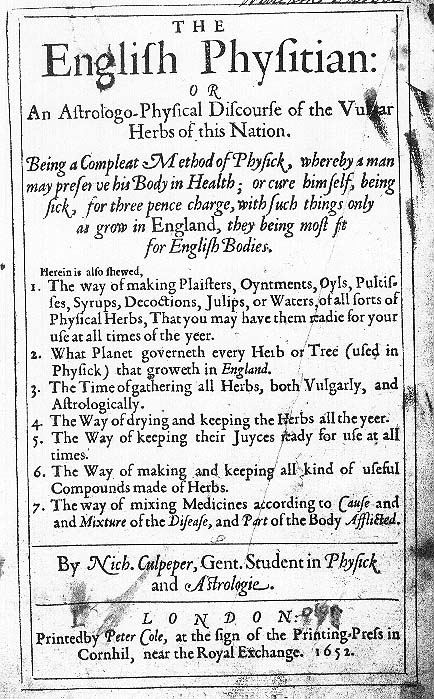|
Astrological Botany
Astrological botany is based on the notion that if plants or seeds are to be used for medicinal purposes then their planting and collection must be carried out with regard to the positions of the planets and other heavenly bodies, which are at the heart of the disease process. For instance, herbs intended to be used on male patients should be gathered when the Sun and Moon are in one of the male signs of the zodiac such as Sagittarius or Aquarius, whereas those for the treatment of females should be gathered under a female sign such as Virgo. Astrological botany was often used in conjunction with the doctrine of signatures, which held that the physical form of a plant reflected its medicinal use. In the words of Agnes Arber, England became "badly infected" with astrological botany during the 17th century, when its most "notorious" practitioner was Nicholas Culpeper. See also *Medical astrology *Nicholas Culpeper Nicholas Culpeper (18 October 1616 – 10 January 1654) was an En ... [...More Info...] [...Related Items...] OR: [Wikipedia] [Google] [Baidu] |
Zodiac
The zodiac is a belt-shaped region of the sky that extends approximately 8° north or south (as measured in celestial latitude) of the ecliptic, the Sun path, apparent path of the Sun across the celestial sphere over the course of the year. The paths of the Moon and visible planets are within the belt of the zodiac. In Western astrology, and formerly astronomy, the zodiac is divided into astrological sign, twelve signs, each occupying 30° of celestial longitude and roughly corresponding to the following star constellations: Aries (astrology), Aries, Taurus (astrology), Taurus, Gemini (astrology), Gemini, Cancer (astrology), Cancer, Leo (astrology), Leo, Virgo (astrology), Virgo, Libra (astrology), Libra, Scorpio (astrology), Scorpio, Sagittarius (astrology), Sagittarius, Capricorn (astrology), Capricorn, Aquarius (astrology), Aquarius, and Pisces (astrology), Pisces. These astrological signs form a celestial coordinate system, or more specifically an ecliptic coordinate sys ... [...More Info...] [...Related Items...] OR: [Wikipedia] [Google] [Baidu] |
Sagittarius (astrology)
Sagittarius () (Greek: Τοξότης ''Toxótēs'') is the ninth astrological sign, which is associated with the constellation Sagittarius and spans 240–270th degrees of the zodiac. Under the tropical zodiac, the sun transits this sign between approximately November 22 and December 21. Greek mythology associates Sagittarius with the centaur Chiron, who mentored Achilles, a Greek hero of the Trojan War, in archery. Sagittarius, the half human and half horse, is the centaur of mythology, the learned healer whose higher intelligence forms a bridge between Earth and Heaven. Also known as the Archer, Sagittarius is represented by the symbol of a bow and arrow. Astrology Along with Aries and Leo, Sagittarius is a part of the Fire Trigon as well as the last of the reproductive trinity. It also follows Gemini and Virgo as third of the mutable signs, which are the signs that feature changeable quality. When Sagittarius is depicted as an archer, then he is classified as human but ... [...More Info...] [...Related Items...] OR: [Wikipedia] [Google] [Baidu] |
Aquarius (astrology)
Aquarius () is the eleventh astrological sign in the zodiac, originating from the Aquarius (constellation), constellation Aquarius. Under the tropical zodiac, the Sun is in the Aquarius sign between about January 20 and about February 18. Myth The water carrier represented by the zodiacal constellation Aquarius is Ganymede (mythology), Ganymede, a beautiful Phrygian youth. Ganymede was the son of Tros, king of Troy (according to Lucian, he was also the son of Dardanus). While tending to his father's flocks on Mount Ida, Ganymede was spotted by Zeus. The king of gods fell in love with him and flew down to the mountain in the form of a large bird, whisking Ganymede away to the heavens. Ever since, the boy has served as cupbearer to the gods. Ovid has Orpheus sing the tale. Constellation Aquarius is a winter constellation in the northern hemisphere, found near Pisces and Cetus. It is especially notable as the radiant for four meteor showers, the largest of which is the Souther ... [...More Info...] [...Related Items...] OR: [Wikipedia] [Google] [Baidu] |
Virgo (astrology)
Virgo () (Greek: Παρθένος, ''Parthenos'') is the sixth astrological sign in the zodiac. It spans the 150–180th degree of the zodiac. Under the tropical zodiac, the Sun transits this area, on average, between August 23 and September 22. Depending on the system of astrology, individuals born during these dates may be called ''Virgos'' or ''Virgoans.'' The sign is associated with Astraea. In Greek mythology, Astraea was the last immortal to abandon Earth at the end of the Silver Age. This was when the gods fled to Olympus – hence the sign's association with Earth. She became the constellation of Virgo. Virgo is one of the three Earth signs, along with Capricorn and Taurus. Origins The constellation Virgo has different origins depending on mythology. Most myths view Virgo as a virgin maiden with associations with wheat. In Greek and Roman mythology, the constellation is related to Demeter, the Greek goddess of the harvest, or her daughter Persephone, queen of t ... [...More Info...] [...Related Items...] OR: [Wikipedia] [Google] [Baidu] |
Doctrine Of Signatures
The doctrine of signatures, dating from the time of Dioscorides and Galen, states that herbs resembling various parts of the body can be used by herbalists to treat ailments of those body parts. A theological justification, as stated by botanists such as William Coles, was that God would have wanted to show men what plants would be useful for. It is today considered to be pseudoscience, and has led to many deaths and severe illnesses. For instance birthwort (so-called because of its resemblance to the uterus), once used widely for pregnancies, is carcinogenic and very damaging to the kidneys, owing to its aristolochic acid content. As a defense against predation, many plants contain toxic chemicals, the action of which is not immediately apparent, or easily tied to the plant rather than other factors History The concept dates from the time of Dioscorides and Galen. Paracelsus (1493–1541) developed the concept, writing that "Nature marks each growth ... according to it ... [...More Info...] [...Related Items...] OR: [Wikipedia] [Google] [Baidu] |
Nicholas Culpeper
Nicholas Culpeper (18 October 1616 – 10 January 1654) was an English botanist, herbalist, physician and astrologer.Patrick Curry: "Culpeper, Nicholas (1616–1654)", ''Oxford Dictionary of National Biography'' (Oxford, UK: OUP, 2004) His book ''The English Physician'' (1652, later ''Complete Herbal'', 1653 ff.) is a source of pharmaceutical and herbal lore of the time, and ''Astrological Judgement of Diseases from the Decumbiture of the Sick'' (1655) one of the most detailed works on medical astrology in Early Modern Europe. Culpeper catalogued hundreds of outdoor medicinal herbs. He scolded contemporaries for some of the methods they used in herbal medicine: "This not being pleasing, and less profitable to me, I consulted with my two brothers, and , and took a voyage to visit my mother , by whose advice, together with the help of , I at last obtained my desire; and, being warned by , a stranger in our days, to publish it to the world, I have done it." Culpeper came from a ... [...More Info...] [...Related Items...] OR: [Wikipedia] [Google] [Baidu] |
Medical Astrology
Medical astrology (traditionally known as iatromathematics) is an ancient applied branch of astrology based mostly on ''melothesia'' (Gr. μελοθεσία), the association of various parts of the body, diseases, and drugs with the nature of the sun, moon, planets, and the twelve astrological signs. The underlying basis for medical astrology, astrology itself, is considered to be a pseudoscience as there is no scientific basis for its core beliefs. Paul R. Thagard,Why Astrology is a Pseudoscience, PSA, vol 1. University of Chicago Press, 1978. Historical references Medical astrology was mentioned by Marcus Manilius (1st century AD) in his epic poem (8000 verses) ''Astronomica''. Publications * Ficino, Marsilio, ''Three Books on Life'' (1489) 'De vita libri tre''translated by Carol V. Kaske and John R. Clark, Center for Medieval and Early Renaissance Studies, State University of New York at Binghamton and The Reaissance Society of America (1989.) * Lilly, William, ''Christ ... [...More Info...] [...Related Items...] OR: [Wikipedia] [Google] [Baidu] |



